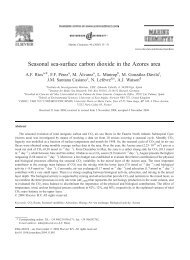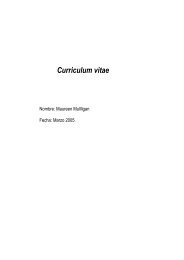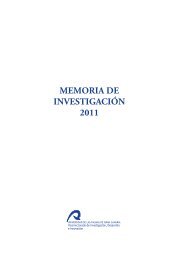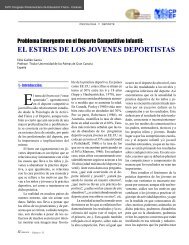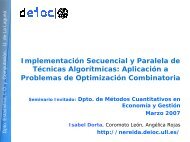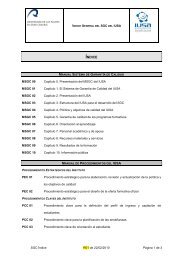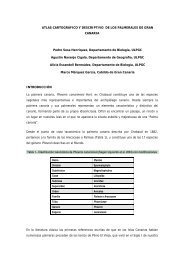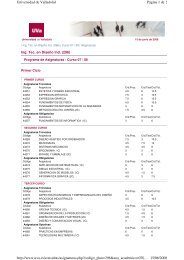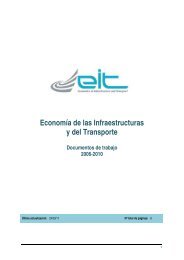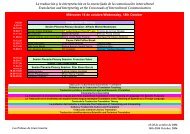Self-concept in University-level FL Learners - ulpgc
Self-concept in University-level FL Learners - ulpgc
Self-concept in University-level FL Learners - ulpgc
You also want an ePaper? Increase the reach of your titles
YUMPU automatically turns print PDFs into web optimized ePapers that Google loves.
<strong>Self</strong>-<strong>concept</strong> <strong>in</strong> <strong>University</strong>-<strong>level</strong> <strong>FL</strong> <strong>Learners</strong><br />
Patricia Arnaiz, <strong>University</strong> of Las Palmas de Gran Canaria, Canary<br />
Islands, Spa<strong>in</strong><br />
Felix Guillen, <strong>University</strong> of Las Palmas de Gran Canaria, Spa<strong>in</strong><br />
Abstract: Exist<strong>in</strong>g research <strong>in</strong>dicates that no other area of study presents as much of a threat to self<strong>concept</strong><br />
as does foreign language learn<strong>in</strong>g. However, few foreign language learn<strong>in</strong>g studies have focused<br />
explicitly on self-<strong>concept</strong>. This study is timely <strong>in</strong> view of the current <strong>in</strong>terest by the Spanish government<br />
<strong>in</strong> promot<strong>in</strong>g foreign languages. It exam<strong>in</strong>ed <strong>in</strong>dividual differences <strong>in</strong> the self-<strong>concept</strong> of 216 participants<br />
<strong>in</strong> a Spanish university context. Participants, English language learners, completed the <strong>Self</strong>-<strong>concept</strong><br />
Scale Form 5-AF5 (García & Musitu, 2001). <strong>Self</strong>-<strong>concept</strong> <strong>level</strong>s both globally and <strong>in</strong> the academic,<br />
social and emotional dimensions were determ<strong>in</strong>ed, and the relationship between self-<strong>concept</strong>, on the<br />
one hand, and gender, age, mark and language <strong>level</strong> on the other hand, was identified. The f<strong>in</strong>d<strong>in</strong>gs<br />
highlight the relevance of this type of study for <strong>in</strong>form<strong>in</strong>g language learn<strong>in</strong>g research. In addition,<br />
important implications for future research are discussed.<br />
Keywords: Foreign Language Learn<strong>in</strong>g, <strong>Self</strong>-<strong>concept</strong>, Mark, Language Level<br />
Introduction<br />
SELF-CONCEPT IS ONE of the oldest constructs <strong>in</strong> the social sciences (James,<br />
1896) and it is widely acknowledged that it plays a central role <strong>in</strong> all learn<strong>in</strong>g situations<br />
(Denissen, Zarrett, & Eccles, 2007; Hattie, 1992; Marsh & Yeung, 1997; Pajares &<br />
Schunk, 2005). Improv<strong>in</strong>g students’ self-<strong>concept</strong> must be seen as a major aim of<br />
education (O’Mara & Marsch, 2006) and has been associated with many educational ga<strong>in</strong>s,<br />
such as better academic achievement, perseverance, coursework choice (Delugach, Bracken,<br />
Bracken, & Schicke, 1992; Marsh & Craven, 2006; Marsh & Yeung, 1997; Valent<strong>in</strong>e,<br />
DuBois, & Cooper, 2004), and attitudes to learn<strong>in</strong>g (Burnett, Pillay, & Dart, 2003).<br />
Historically, self-<strong>concept</strong> research has been dom<strong>in</strong>ated by a unidimensional perspective<br />
<strong>in</strong> which self-<strong>concept</strong>ions were considered to be relatively consistent and undifferentiated<br />
across social, academic, physical, and other doma<strong>in</strong>s (Byrne, 1984; Coopersmith, 1967;<br />
Marx & W<strong>in</strong>ne, 1978; Wylie, 1989). As these researchers believed self-<strong>concept</strong> to be the<br />
sum total of an <strong>in</strong>dividual’s self-perceptions, total self-<strong>concept</strong> was represented by a s<strong>in</strong>gle<br />
score. But <strong>in</strong> their review of self-<strong>concept</strong> research, Shavelson, Hubner, & Stanton (1976)<br />
<strong>in</strong>tegrated several def<strong>in</strong>itions of self-<strong>concept</strong>. Accord<strong>in</strong>g to their <strong>in</strong>tegrated def<strong>in</strong>ition, self<strong>concept</strong><br />
consists of a person’s self-perceptions built through experience with —and <strong>in</strong>terpretations<br />
of— one’s environment. These self-perceptions are <strong>in</strong>fluenced ma<strong>in</strong>ly by evaluations<br />
by significant others, re<strong>in</strong>forcements, and attributions for one’s own behavior. Shavelson et<br />
al. (1976) <strong>in</strong>dicated that self-<strong>concept</strong> is both evaluative and descriptive, and that it has a<br />
multifaceted and hierarchical organization. Perceptions of personal behavior <strong>in</strong> certa<strong>in</strong> situations<br />
are situated at the base of the hierarchy, <strong>in</strong>ferences about self <strong>in</strong> broader doma<strong>in</strong>s (e.g.,<br />
The International Journal of the Humanities<br />
Volume 9, Issue 4, 2012, http://www.Humanities-Journal.com, ISSN 1447-9508<br />
© Common Ground, Patricia Arnaiz, Felix Guillen, All Rights Reserved, Permissions:<br />
cg-support@commongroundpublish<strong>in</strong>g.com
THE INTERNATIONAL JOURNAL OF THE HUMANITIES<br />
social, physical, and academic) are at the middle of the hierarchy, and a general self-<strong>concept</strong><br />
is found at the apex. Nowadays it is generally accepted that self-<strong>concept</strong> functions <strong>in</strong> separate<br />
doma<strong>in</strong>s, i.e., self-beliefs are classified accord<strong>in</strong>g to a specific field (Marsh, Byrne, &<br />
Shavelson, 1988; Marsh & Yeung, 1996, 1997, 1998; Valent<strong>in</strong>e, DuBois, & Cooper, 2004).<br />
Academic self-<strong>concept</strong>, for example, is an <strong>in</strong>dividual’s self-perception of competence and<br />
his/her evaluative judgments <strong>in</strong> the academic doma<strong>in</strong> (Mercer, 2011, p. 14).<br />
There is sufficient research evidence to assert that self-<strong>concept</strong> <strong>in</strong>fluences behavior. What<br />
students feel about themselves will determ<strong>in</strong>e the way they deal with the challenges of the<br />
learn<strong>in</strong>g experience and also their relationship with others (Arnold, 2007). In their research<br />
with university students on another self-related construct, self-esteem, Brown and Smart<br />
(1991) observed that subjects who saw themselves as k<strong>in</strong>d and helpful had prosocial behavior.<br />
They also noticed that those with high self-esteem had less difficulty preserv<strong>in</strong>g a positive<br />
view of themselves after failure. Subjects with low self-esteem, however, not only found it<br />
hard to reaffirm their self-image after failure, but also had a tendency to behave egotistically.<br />
Their conclusion may be of relevance for the purposes of our study: “self-presentations appear<br />
to play a critical role <strong>in</strong> guid<strong>in</strong>g and regulat<strong>in</strong>g behavior” (Brown & Smart, 1991, p. 373).<br />
More than <strong>in</strong> any other discipl<strong>in</strong>e, <strong>in</strong> foreign language learn<strong>in</strong>g our self-<strong>concept</strong> can be<br />
severely damaged (Arnold, 2007; Mercer, 2011). Language learn<strong>in</strong>g is much more “ego-<strong>in</strong>volv<strong>in</strong>g”<br />
than other areas of study (Horwitz, 2007). Due to the <strong>in</strong>tr<strong>in</strong>sically social nature of<br />
the language learn<strong>in</strong>g process (Jones, 2008; Williams & Burden, 1997), a very common<br />
problem <strong>in</strong> language learners is that they feel their ideas are not expressed properly <strong>in</strong> the<br />
target language and this may make them appear immature or foolish (Arnold & Brown,<br />
1999; Pellegr<strong>in</strong>o, 2005). The use of a language of which the <strong>in</strong>dividual does not have full<br />
command, makes the self especially vulnerable (Tsui, 1996, p. 155). As Mercer (2011) accurately<br />
expla<strong>in</strong>s, it is that “visibility” characteristic of the language learn<strong>in</strong>g process, at<br />
least as regards the oral skill, that may turn it <strong>in</strong>to an emotional ordeal.<br />
Therefore, and if effective learn<strong>in</strong>g is what we are after, the relevance of psychological<br />
variables to learn<strong>in</strong>g should not be questioned. As Rodríguez, Plax and Kearney (1996: 297)<br />
have stated, “Affect is, by def<strong>in</strong>ition, an <strong>in</strong>tr<strong>in</strong>sic motivator. Positive affect susta<strong>in</strong>s <strong>in</strong>volvement<br />
and deepens <strong>in</strong>terest <strong>in</strong> the subject matter”. Another author who has po<strong>in</strong>ted <strong>in</strong> the<br />
same direction is Stevick (1980: 4), contend<strong>in</strong>g that success <strong>in</strong> foreign language learn<strong>in</strong>g<br />
depends more on what happens <strong>in</strong>side and between the people <strong>in</strong> the classroom than on<br />
materials and techniques. As Arnold and Brown (1999) expla<strong>in</strong>, the most orig<strong>in</strong>al techniques<br />
and the most appeal<strong>in</strong>g materials may turn out to be useless if negative emotional factors<br />
are present <strong>in</strong> the learn<strong>in</strong>g context.<br />
One of the major areas of focus <strong>in</strong> connection with self-<strong>concept</strong> is students’ past<br />
achievement experiences. As regards the nature and directionality of the relationship between<br />
academic self-<strong>concept</strong> and academic achievement, f<strong>in</strong>d<strong>in</strong>gs <strong>in</strong> psychology-based research<br />
have been contradictory. In the 70s, two models were suggested by Calsyn and Kenny (1977).<br />
The first one, “The Skill Development Model” suggests that academic achievement <strong>in</strong>fluences<br />
self-beliefs but that self-beliefs do not <strong>in</strong>fluence achievement. By contrast, the “<strong>Self</strong>-Enhancement<br />
Model” <strong>in</strong>dicates that self-beliefs <strong>in</strong>fluence academic achievement but that academic<br />
achievement does not <strong>in</strong>fluence self-beliefs. A third model was later presented, the “Reciprocal<br />
Effects Model” (REM), <strong>in</strong> which self-<strong>concept</strong> and achievement are reciprocally related<br />
and mutually re<strong>in</strong>forc<strong>in</strong>g (Marsh, 1990; Marsh & Yeung, 1997). Therefore, accord<strong>in</strong>g to the<br />
REM model, previous self-<strong>concept</strong> affects ensu<strong>in</strong>g achievement, but previous achievement<br />
82
PATRICIA ARNAIZ, FELIX GUILLEN<br />
also affects ensu<strong>in</strong>g self-<strong>concept</strong> development, and this contention has been supported by<br />
most studies (Guay, Marsh, & Boiv<strong>in</strong>, 2003; Liu, 2008; Marsh, Hau, & Kong, 2002).<br />
There seems to be no doubt that self-<strong>concept</strong> plays a key role <strong>in</strong> all learn<strong>in</strong>g contexts<br />
(Denissen, Zarrett & Eccles, 2007; Hattie, 1992; Marsh & Yeung, 1997). However, and <strong>in</strong><br />
spite of the fact that self-related constructs appear <strong>in</strong> a wide variety of areas of SLA research,<br />
such as anxiety (Aida, 1994; Arnaiz & Guillén, <strong>in</strong> press; Casado & Dereshiwsky, 2001;<br />
Cheng, Horwitz, & Schallert, 1999; Horwitz, 2001; Horwitz, Horwitz & Cope, 1986), motivation<br />
(Dörnyei & Ushioda, 2009), strategies (Woodrow, 2006), beliefs (Horwitz et al.,<br />
2004), metacognition (Wenden, 2001), Will<strong>in</strong>gness to Communicate (WTC) (Yashima, Zenuk-Nishide<br />
& Shimizu, 2004), and <strong>in</strong>dividual differences (Ehrman, Leaver, & Oxford,<br />
2003), the number of studies that have approached self-<strong>concept</strong> explicitly <strong>in</strong> language learners<br />
is low. Furthermore, <strong>in</strong> the literature reviewed, no self-<strong>concept</strong> studies have been found that<br />
have centred their attention on Spanish <strong>University</strong> English foreign language (E<strong>FL</strong>) students.<br />
This research aims to shed light on the general self-<strong>concept</strong> <strong>level</strong>s of Spanish university<br />
students learn<strong>in</strong>g English as part of their degree. It will explore three of the five dimensions<br />
that make up the theoretical model selected: the academic, the social and the emotional dimensions.<br />
Although, as mentioned earlier, self-<strong>concept</strong> functions <strong>in</strong> separate doma<strong>in</strong>s and<br />
consequently, research <strong>in</strong>to self-<strong>concept</strong> should be carried out at the doma<strong>in</strong>-specific <strong>level</strong><br />
(Marsh, Byrne, & Shavelson, 1988; Marsh & Yeung, 1996, 1997, 1998; Yeung & Lee, 1999;<br />
Yeung & Wong, 2004), there are also advantages <strong>in</strong> tak<strong>in</strong>g a more holistic perspective<br />
(Mercer, 2011). If we want to understand the nature and content of a learner’s E<strong>FL</strong> self<strong>concept</strong>,<br />
it should be born <strong>in</strong> m<strong>in</strong>d that learners often refer to other doma<strong>in</strong>s, which they<br />
perceive as important and related, when describ<strong>in</strong>g themselves as E<strong>FL</strong> learners. Thus, <strong>in</strong><br />
order to understand how a learner may see himself /herself <strong>in</strong> a certa<strong>in</strong> <strong>FL</strong> doma<strong>in</strong>, it may<br />
be necessary first of all to take a holistic view of the learner, which will allow us to get <strong>in</strong>formation<br />
about a learner’s self-beliefs <strong>in</strong> other doma<strong>in</strong>s.<br />
Consider<strong>in</strong>g the difficulty Spanish students have traditionally encountered when study<strong>in</strong>g<br />
English, and the fact that self-<strong>concept</strong> might be one of the factors that could be h<strong>in</strong>der<strong>in</strong>g<br />
the learn<strong>in</strong>g process, we wanted to carry out a prelim<strong>in</strong>ary study which collected data about<br />
this construct and analyzed some of the factors that might be <strong>in</strong>fluenc<strong>in</strong>g it. This study is<br />
timely <strong>in</strong> view of the Spanish education authorities’ current <strong>in</strong>terest <strong>in</strong> promot<strong>in</strong>g foreign<br />
languages. The follow<strong>in</strong>g research questions were developed for this study:<br />
1. Do self-<strong>concept</strong> <strong>level</strong>s vary among learners with different marks <strong>in</strong> English?<br />
2. Do self-<strong>concept</strong> <strong>level</strong>s vary among learners who had chosen English as a ma<strong>in</strong> subject<br />
and students for whom English was a non-elective obligatory subject?<br />
3. Do self-<strong>concept</strong> <strong>level</strong>s vary among pre-service Primary English teachers and pre-service<br />
Primary Generalist, Music or Physical Education teachers?<br />
4. How do self-<strong>concept</strong> <strong>level</strong>s relate to language <strong>level</strong> and mark?<br />
83
THE INTERNATIONAL JOURNAL OF THE HUMANITIES<br />
Method<br />
Participants<br />
Participants <strong>in</strong> this study consisted of 216 students enrolled <strong>in</strong> different English language<br />
courses <strong>in</strong> a Spanish university. Their language <strong>level</strong>s <strong>in</strong> English ranged from B1 to C1 1 .<br />
The sample consisted of 120 females (55.5%) and 96 males (44.5%). The respondents<br />
ranged <strong>in</strong> age from 18 to 39, with a mean age of 20.39 (SD = 3.69) and came from six different<br />
degree programmes. There were 156 students from the Teacher Tra<strong>in</strong><strong>in</strong>g Faculty, 59 of<br />
whom were study<strong>in</strong>g to be Primary English teachers, which means English was their ma<strong>in</strong><br />
chosen subject and was consequently a voluntary part of their curriculum, while 97 of them<br />
were study<strong>in</strong>g to be Primary Generalist teachers, Physical Education teachers and Music<br />
teachers, for whom English was a non-elective degree requirement. The other two groups<br />
of students came from the Translation and Interpret<strong>in</strong>g Faculty (30) and the Computer Science<br />
Faculty (30). The former had English as a ma<strong>in</strong> chosen subject, i.e. they were study<strong>in</strong>g it<br />
voluntarily, while for the latter it was a prerequisite for graduation.<br />
Prior to the study, all participants agreed to sign the consent form which <strong>in</strong>dicated the aim<br />
and characteristics of the study.<br />
Instrument<br />
The questionnaire Auto<strong>concept</strong>o Forma 5 [AF5: <strong>Self</strong>-<strong>concept</strong> form] (García & Musitu, 2001)<br />
was used to measure students’ self-<strong>concept</strong>. The scale consisted of 30 items and five subscales,<br />
but only the data for three of the subscales will be analyzed here: the academic self-<strong>concept</strong>,<br />
the social self-<strong>concept</strong>, and the emotional self-<strong>concept</strong> subscales.<br />
The items were evaluated on a scale from 1 to 99, “1” be<strong>in</strong>g the score which <strong>in</strong>dicated<br />
total disagreement and “99” that of total agreement with the item. For the analysis of the<br />
results, the scale was converted <strong>in</strong>to a scale from 1 to 10.<br />
Furthermore, a background questionnaire <strong>in</strong>clud<strong>in</strong>g <strong>in</strong>formation regard<strong>in</strong>g students’ language<br />
<strong>level</strong>, gender, age, and the last mark obta<strong>in</strong>ed <strong>in</strong> English was used.<br />
Procedure<br />
Permission was requested from the deans of the three Faculties <strong>in</strong>volved to conduct the<br />
survey.<br />
Once the pr<strong>in</strong>cipal <strong>in</strong>vestigator had expla<strong>in</strong>ed the purpose of the study, the participants<br />
were asked to complete the background questionnaire. Subsequently, the Spanish students<br />
were given the questionnaire Auto<strong>concept</strong>o Forma 5 [AF5: <strong>Self</strong>-<strong>concept</strong> form]. Participants<br />
had about 20 m<strong>in</strong>utes to complete the questionnaires dur<strong>in</strong>g class time.<br />
1 The language <strong>level</strong>s were established follow<strong>in</strong>g The Common European Framework of Reference for Languages:<br />
Learn<strong>in</strong>g, Teach<strong>in</strong>g, Assessment (CEFR) (2001), a guidel<strong>in</strong>e used to describe achievements of learners of foreign<br />
languages across Europe. The 2008 study by Martínez Baztán has addressed correspondence with The American<br />
Council on the Teach<strong>in</strong>g of Foreign Languages (ACT<strong>FL</strong>) Guidel<strong>in</strong>es. Thus, B1 would correspond to Intermediate<br />
Mid and Intermediate High, B2 would correspond to Intermediate High and Advanced Low, and C1, to Advanced<br />
Mid, Advanced High.<br />
84
PATRICIA ARNAIZ, FELIX GUILLEN<br />
Data Analysis<br />
The analyses described below were performed us<strong>in</strong>g the SPSS 17.0 for W<strong>in</strong>dows. Descriptive<br />
statistics were calculated to exam<strong>in</strong>e students’ self-<strong>concept</strong>. The mean and standard deviations<br />
of the self-<strong>concept</strong> scale and subscales were computed for the whole group, and separated<br />
accord<strong>in</strong>g to the marks obta<strong>in</strong>ed and the degree course selected by students. Participants<br />
were divided <strong>in</strong>to three groups accord<strong>in</strong>g to the marks obta<strong>in</strong>ed <strong>in</strong> English <strong>in</strong> the first semester<br />
of the academic year. One group was formed by low ability students (marks from 2 to 5),<br />
another group by average ability students (marks from 6 to 7), and a third group by high<br />
ability students (marks from 8 to 10). F<strong>in</strong>ally, and <strong>in</strong> order to exam<strong>in</strong>e the relationship<br />
between the self-<strong>concept</strong> scale and subscales, on the one hand, and the variables <strong>level</strong> and<br />
mark, on the other hand, a correlation analysis was conducted on the full sample.<br />
Results<br />
Though the questionnaire Auto<strong>concept</strong>o Forma 5 [AF5: <strong>Self</strong>-<strong>concept</strong> form] is a standardized<br />
<strong>in</strong>strument (with confirmed reliability, discrim<strong>in</strong>ation validity, and construct validity), the<br />
Cronbach’s alpha coefficient of <strong>in</strong>ternal consistency for the scale was calculated. The <strong>in</strong>ternal<br />
consistency (reliability) of the total scale was .76, confirm<strong>in</strong>g that the items of the scale are<br />
clearly measur<strong>in</strong>g the same construct. The <strong>in</strong>ternal consistency coefficients for the subscale<br />
scores were also acceptable, stand<strong>in</strong>g at .76 for academic self-<strong>concept</strong>, .74 for social self<strong>concept</strong>,<br />
and .81 for emotional self-<strong>concept</strong>.<br />
The means and standard deviations of the global self-<strong>concept</strong> and the academic, social<br />
and emotional self-<strong>concept</strong>s of each ability group were computed (Table 1). No significant<br />
differences were observed between the three groups created.<br />
Table 1: Mean Values and ANOVA Test of <strong>Self</strong>-<strong>concept</strong> Levels by Mark<br />
3 groups<br />
2 - 5<br />
6 - 7<br />
8 - 10<br />
(n = 51) (n = 88) (n = 62)<br />
Mean (SD) Mean (SD) Mean (SD) F<br />
Academic 6.81 (1.55) 6.53 (1.98) 7.03 (1.45) 1.50<br />
Social<br />
7.11 (1.68) 7.19 (1.74) 7.32 (1.47) .246<br />
Emotional 4.84 (1.89) 5.22 (2.20) 5.56 (2.21) 1.61<br />
TOTAL 6.84 (.76) 6.70 (.90) 6.78 (.94) .413<br />
p<br />
.224<br />
.782<br />
.201<br />
.662<br />
Two <strong>in</strong>dependent sample t-test analyses were performed. The first was aimed at determ<strong>in</strong><strong>in</strong>g<br />
the differences <strong>in</strong> self-<strong>concept</strong> <strong>level</strong>s between the group who had English as a ma<strong>in</strong> subject<br />
(i.e. had chosen to study it voluntarily) and the group for whom it was non-elective degree<br />
requirement (i.e. a prerequisite for graduation). No statistical differences were revealed<br />
(Table 2).<br />
85
THE INTERNATIONAL JOURNAL OF THE HUMANITIES<br />
Table 2: Mean Values and T-test of <strong>Self</strong>-<strong>concept</strong> Subscales and Total Scores by Degree<br />
Type<br />
Academic<br />
Social<br />
Emotional<br />
Global<br />
English MS<br />
(n = 89 )<br />
Mean (SD)<br />
6.74 (1.79)<br />
7.18 (1.80)<br />
5.04 (2.07)<br />
6.72 (.88)<br />
English DR<br />
(n = 125 )<br />
Mean (SD)<br />
6.81 (1.72)<br />
7.25 (1.57)<br />
5.32 (2.14)<br />
6.81 (.87)<br />
t (p)<br />
-.286 (.775)<br />
-.295 (.768)<br />
-.951 (.343)<br />
-.757 (.450)<br />
English MS = English as a ma<strong>in</strong> chosen subject; English DR = English as a degree<br />
requirement<br />
The second <strong>in</strong>dependent sample t-test analysis was carried out to discover the differences<br />
<strong>in</strong> self-<strong>concept</strong> <strong>level</strong>s between the group who had English as a ma<strong>in</strong> subject and the group<br />
who had it as a non-elective degree requirement. No statistical differences were detected<br />
(Table 3).<br />
Table 3: Mean Values and T-test of <strong>Self</strong>-<strong>concept</strong> Subscales and Total Scores <strong>in</strong> Future<br />
Teachers<br />
Academic<br />
Social<br />
Emotional<br />
Global<br />
PET<br />
(n = 59 )<br />
Mean (SD)<br />
7.00 (1.82)<br />
7.32 (1.58)<br />
4.89 (2.17)<br />
6.84 (.88)<br />
PT<br />
(n = 95)<br />
Mean (SD)<br />
7.04 (1.58)<br />
7.45 (1.50)<br />
5.11 (2.08)<br />
6.97 (.83)<br />
t (p)<br />
-.148 (.883)<br />
-.501 (.617)<br />
-.645 (.520)<br />
-.883 (.379)<br />
PET = future Primary English teachers ; PT = future Generalist, Music and Physical Education<br />
teachers<br />
In order to ga<strong>in</strong> more understand<strong>in</strong>g of students’ self-<strong>concept</strong>, a correlation analysis was<br />
conducted on the full sample to <strong>in</strong>vestigate the relationships between the total scale and the<br />
academic, social and emotional subscales, on the one hand, and <strong>level</strong> and mark, on the other<br />
hand (Table 4).<br />
With respect to <strong>level</strong>, significant negative correlations were detected between <strong>level</strong> and<br />
academic self-<strong>concept</strong> (r = -.135) and <strong>level</strong> and the global score of the scale (r = -.266); and<br />
a significant positive correlation was found between <strong>level</strong> and the social subscale (r = .154).<br />
As regards the variable mark, it was observed that it ma<strong>in</strong>ta<strong>in</strong>ed a significant positive<br />
correlation with the emotional subscale (r =.158).<br />
86
PATRICIA ARNAIZ, FELIX GUILLEN<br />
Table 4: Pearson Product-moment Correlations Among <strong>Self</strong>-<strong>concept</strong> Subscales the<br />
Total Scale, and Level, and Mark<br />
Level<br />
Mark<br />
Discussion<br />
Level<br />
Mark<br />
.076<br />
Academic<br />
-.135*<br />
.079<br />
Social<br />
.154*<br />
.090<br />
Emotional<br />
.105<br />
.158*<br />
Global<br />
-.266**<br />
-.003<br />
The study was ma<strong>in</strong>ly designed to ga<strong>in</strong> <strong>in</strong>sight <strong>in</strong>to one important determ<strong>in</strong>ant of the foreign<br />
language learn<strong>in</strong>g process, students’ self-<strong>concept</strong>, and its relation with the variables selected.<br />
Through a global self-<strong>concept</strong> scale, this prelim<strong>in</strong>ary study attempted to elucidate the self<strong>concept</strong><br />
<strong>level</strong>s of university learners of English enrolled <strong>in</strong> different degrees with the aim of<br />
collect<strong>in</strong>g data <strong>in</strong> a somewhat unexplored context, that of a university <strong>in</strong> Spa<strong>in</strong>.<br />
The results of the present study <strong>in</strong>dicate that self-<strong>concept</strong> <strong>level</strong>s <strong>in</strong> students with different<br />
marks <strong>in</strong> English do not differ significantly. These f<strong>in</strong>d<strong>in</strong>gs contradict previous research<br />
show<strong>in</strong>g that positive self-<strong>concept</strong> was l<strong>in</strong>ked to high academic achievement (Liu, 2009;<br />
Marsh, Smith & Barnes, 1985).<br />
In terms of differences between the self-<strong>concept</strong> <strong>level</strong>s of students with different <strong>level</strong>s<br />
of English, it was observed that those at a higher <strong>level</strong> have lower academic and global self<strong>concept</strong><br />
<strong>level</strong>s. These f<strong>in</strong>d<strong>in</strong>gs corroborate L<strong>in</strong> & Sheen’s (1996) statement that self-<strong>concept</strong><br />
<strong>level</strong>s tend to be higher <strong>in</strong> the early stages of foreign language learn<strong>in</strong>g. For a possible <strong>in</strong>terpretation<br />
of the results <strong>in</strong> the present study, we can refer to Horwitz’s (2007) explanation<br />
about <strong>level</strong>s of anxiety -another self-related construct- <strong>in</strong> language learners. <strong>Learners</strong> very<br />
often experience anxiety when speak<strong>in</strong>g a foreign language, and higher <strong>level</strong> learners may<br />
experience more anxiety than lower <strong>level</strong> learners when communicat<strong>in</strong>g <strong>in</strong> a foreign language,<br />
s<strong>in</strong>ce they may be more sensitive to differences between their mature thoughts and the actual<br />
messages they are able to transmit, which may sometimes sound puerile. As learners advance<br />
<strong>in</strong> their language mastery, they may become more aware of their limitations and weaknesses.<br />
Likewise, how learners feel about themselves may vary across the different stages of the<br />
language learn<strong>in</strong>g process.<br />
But f<strong>in</strong>d<strong>in</strong>gs to the contrary have also been encountered. In the research by Liu (2010)<br />
carried out with first-year university students who were receiv<strong>in</strong>g English <strong>in</strong>struction at the<br />
<strong>University</strong> of Taiwan, the correlation between academic self-<strong>concept</strong> and <strong>level</strong> was not only<br />
a positive correlation but also a strong one, so the higher ability group reported higher self<strong>concept</strong><br />
<strong>level</strong>s than the lower ability group.<br />
As for the self-<strong>concept</strong> <strong>level</strong>s <strong>in</strong> learners enrolled <strong>in</strong> different degrees, unexpectedly, no<br />
significant differences were found. Our <strong>in</strong>terest <strong>in</strong> study<strong>in</strong>g the self-<strong>concept</strong> <strong>in</strong> learners specializ<strong>in</strong>g<br />
to be future language teachers can be justified by the belief that a lack of self-<strong>concept</strong><br />
now may become a lack of self-<strong>concept</strong> when they actually become teachers, and this may<br />
well limit the experiences they provide to their students. Aga<strong>in</strong>, due to the close connection<br />
between self-<strong>concept</strong> and anxiety, we can refer to Horwitz’s theories related to the relevance<br />
of anxiety <strong>level</strong>s for language learners. Horwitz (1996) expla<strong>in</strong>s that the fact that a teacher<br />
completes the required course to become certified to teach English does not mean his/her<br />
language learn<strong>in</strong>g process has f<strong>in</strong>ished. Therefore, an anxious learner will probably become<br />
an anxious teacher, which means he or she will have difficulty <strong>in</strong> offer<strong>in</strong>g a comfortable<br />
87
THE INTERNATIONAL JOURNAL OF THE HUMANITIES<br />
classroom atmosphere that facilitates the use of the foreign language. His/her l<strong>in</strong>guistic <strong>in</strong>teractions<br />
and <strong>in</strong>structional strategies will be more controlled and predictable and this is very<br />
likely to deprive learners of the opportunity of enjoy<strong>in</strong>g a variety of classroom experiences.<br />
We consider that exactly the same theory can be applied to self-<strong>concept</strong>.<br />
Without doubt, more research is needed <strong>in</strong> this direction. The figures obta<strong>in</strong>ed <strong>in</strong> this<br />
prelim<strong>in</strong>ary study should be complemented with figures obta<strong>in</strong>ed from research carried out<br />
with a doma<strong>in</strong>-specific self-<strong>concept</strong> scale. As Marsh (2006, pp. 16) po<strong>in</strong>ts out, “if researchers<br />
are specifically <strong>in</strong>terested <strong>in</strong> self-<strong>concept</strong>s <strong>in</strong> particular academic subjects, then they should<br />
measure self-<strong>concept</strong>s with scales specific to those subjects” Future research could make<br />
use of the self-<strong>concept</strong> scale elaborated by Roncel Vega (2006) and adm<strong>in</strong>istered to English<br />
learners of Spanish as a foreign language and Slovenian learners of Spanish as a foreign<br />
language (Roncel Vega, 2008).<br />
Help<strong>in</strong>g students to <strong>in</strong>crease their self-<strong>concept</strong> <strong>level</strong>s should be one of the key aims of<br />
any foreign language program. Consequently, the more detailed the <strong>in</strong>formation provided<br />
about learners by this research area, the higher the probability of hav<strong>in</strong>g successful foreign<br />
language teach<strong>in</strong>g/learn<strong>in</strong>g sessions. As noted by Arnold and Brown (1999), the relationship<br />
between affect and language learn<strong>in</strong>g is bidirectional. Attention to affect can improve the<br />
language learn<strong>in</strong>g process and the language sessions can help build<strong>in</strong>g up students’ affective<br />
side.<br />
Acknowledgement<br />
The authors would like to thank Heather Adams, ULPGC, for check<strong>in</strong>g the f<strong>in</strong>al English<br />
version of the manuscript.<br />
88
PATRICIA ARNAIZ, FELIX GUILLEN<br />
References<br />
Aida, Y. (1994). Exam<strong>in</strong>ation of Horwitz, Horwitz and Cope’s construct of foreign language anxiety:<br />
the case of students of Japanese. Modern Language Journal 78, 155–168.<br />
Arnaiz, P., & Guillén, F. (<strong>in</strong> press). Foreign language anxiety <strong>in</strong> a Spanish university sett<strong>in</strong>g: <strong>in</strong>terpersonal<br />
differences. Revista Psicodidáctica.<br />
Arnold, J. (2007). <strong>Self</strong>-<strong>concept</strong> as part of the affective doma<strong>in</strong> <strong>in</strong> language learn<strong>in</strong>g. In F. Rubio (Ed.),<br />
<strong>Self</strong>-esteem and foreign language learn<strong>in</strong>g (pp. 13–29). Newcastle: UK. Cambridge Scholars<br />
Publish<strong>in</strong>g.<br />
Arnold, J., & Brown, H. D. (1999). A map of the terra<strong>in</strong>. In J. Arnold (Ed.), Affect <strong>in</strong> language learn<strong>in</strong>g<br />
(pp. 1–27). Cambridge: Cambridge <strong>University</strong> Press.<br />
Brown, J. D., & Smart, S.A. (1991). The self and social conduct: L<strong>in</strong>k<strong>in</strong>g self-representations to<br />
prosocial behavior. Journal of Personality and Social Psychology, 60, 368–375.<br />
Burnett, P. C., Pillay, H., & Dart, B. C. (2003). The <strong>in</strong>fluences of <strong>concept</strong>ions of learn<strong>in</strong>g and learner<br />
self-<strong>concept</strong> on high school students’ approaches to learn<strong>in</strong>g. School Psychology International,<br />
24, 54–66.<br />
Byrne, B. M. (1984). The general/academic self-<strong>concept</strong> nomological network: A review of construct<br />
validation research. Review of Educational Research, 54, 427–456.<br />
Calsyn, R. J., & Kenny, D. (1977). <strong>Self</strong>-<strong>concept</strong> of ability and perceived evaluation of others: Cause<br />
or effect of academic achievement. Journal of Educational Psychology, 69, 154–163.<br />
Casado, M. A., & Dereshiwsky, M. I. (2001). Foreign language anxiety of university students. College<br />
Student Journal, 35(4), 539–549.<br />
Cheng, Y. S., Horwitz, E., & Schallert, D. L. (1999). Language anxiety: differentiat<strong>in</strong>g writ<strong>in</strong>g and<br />
speak<strong>in</strong>g components. Language Learn<strong>in</strong>g, 49(3), 417–446.<br />
Coopersmith, S. A. (1967). The antecedents of self-esteem. San Francisco: Freeman.<br />
Delugach, R. R., Bracken, B. A., Bracken, M. J., & Schicke, M. C. (1992). <strong>Self</strong>-<strong>concept</strong>: Multidimensional<br />
construct exploration. Psychology <strong>in</strong> the Schools, 29, 213–223.<br />
Denissen, J. J. A., Zarrett, N. R., & Eccles, J. S. (2007). I like to do it, I’m able, and I know I am:<br />
Longitud<strong>in</strong>al coupl<strong>in</strong>gs between doma<strong>in</strong>-specific achievement, self-<strong>concept</strong> and <strong>in</strong>terest.<br />
Child Development, 78(2), 430–447.<br />
Dörnyei, Z., & Ushioda, E. (2009). Motivation, language identity and the L2 self. Bristol: Multil<strong>in</strong>gual<br />
Matters.<br />
Ehrman, M. E., Leaver, B. L., & Oxford, R. (2003). A brief overview of <strong>in</strong>dividual differences <strong>in</strong><br />
second language learn<strong>in</strong>g. System 31(3), 313–330.<br />
García, F., & Musitu, G. (2001). AF5: Auto<strong>concept</strong>o Forma 5 [AF5: <strong>Self</strong>-<strong>concept</strong> form 5] (2nd ed.).<br />
Madrid, Spa<strong>in</strong>: TEA.<br />
Guay, F., Marsh, H. W., & Boiv<strong>in</strong>, M. (2003). Academic self-<strong>concept</strong> and academic achievement:<br />
Developmental perspectives on their causal order<strong>in</strong>g. Journal of Educational Psychology,<br />
95, 124–136.<br />
Hattie, J. A. (1992). <strong>Self</strong>-<strong>concept</strong>. Hillsdale, NJ: Lawrence Erlbaum Associates.<br />
Horwitz, E. K. (1996). Even teachers get the blues: Recogniz<strong>in</strong>g and alleviat<strong>in</strong>g non-native teachers’<br />
feel<strong>in</strong>gs of foreign language anxiety. Foreign Language Annals 29, 365–372.<br />
Horwitz, E. K. (2001). Language anxiety and achievement. Annual Review of Applied L<strong>in</strong>guistics, 21,<br />
112–126.<br />
Horwitz, E. K. (2007). Foreword. In F. Rubio (Ed.), <strong>Self</strong>-esteem and foreign language learn<strong>in</strong>g (pp.<br />
ix- xi). Newcastle: UK. Cambridge Scholars Publish<strong>in</strong>g.<br />
Horwitz, E. K., Horwitz, M. B., & Cope, J. A. (1986). Foreign language classroom anxiety. Modern<br />
Language Journal, 70, 125–132.<br />
Horwitz, E. K., Hsieh, P. H., Bonzo, J. D., Huang, D., Na, Y. H., & Rubrecht, B. G. (2004). Case<br />
studies of language learners as a tool for help<strong>in</strong>g teachers understand the experience of language<br />
learn<strong>in</strong>g. Hong Kong Journal of Applied L<strong>in</strong>guistics, 9, 1–14.<br />
89
THE INTERNATIONAL JOURNAL OF THE HUMANITIES<br />
James, W. (1896). Talks to teachers. New York: Norton.<br />
Jones, J. F. (2008). A cultural context for language anxiety. EA Journal 21(2), 30–39.<br />
L<strong>in</strong>, H. P., & Shen, S. S. (1996). Perceptual learn<strong>in</strong>g style preference for E<strong>FL</strong> students. Reports-Research<br />
(143). Taiwan: Chian Nan Junior Collegue of Pharmacy.<br />
Liu, H. J. (2008). The relationship between E<strong>FL</strong> student academic self-<strong>concept</strong> and language performance.<br />
Feng Chia Journal of Humanities and Social Sciences, 17, 165–184.<br />
Liu, H. J. (2009). Explor<strong>in</strong>g changes <strong>in</strong> academic self-<strong>concept</strong> <strong>in</strong> ability-grouped English classes.<br />
Chang Gung Journal of Humanities and Social Sciences 2(2), 411–432.<br />
Liu, H. J. (2010). The relation of academic self-<strong>concept</strong> to motivation among university E<strong>FL</strong> students.<br />
Feng Chia Journal of Humanities and Social Sciences, 20, 207–225.<br />
Marsh, H. W. (1986). Verbal and math self-<strong>concept</strong>s: An <strong>in</strong>ternal/external frame of reference model.<br />
American Educational Research Journal, 23, 129–149.<br />
Marsh, H. W. (1990). The structure of academic self-<strong>concept</strong>: The Marsh/Shavelson model. Journal<br />
of Educational Psychology, 82, 623–636.<br />
Marsh, H. W. (1999). Academic <strong>Self</strong> Description Questionnaire – I: ASDQ I, <strong>University</strong> of Western<br />
Sydney, <strong>Self</strong>-<strong>concept</strong> Enhancement and Learn<strong>in</strong>g Facilitation Research Centre, Macarthur,<br />
Australia.<br />
Marsh, H. W., Byrne, B. M., & Shavelson, R. J. (1988). A multifaceted academic self-<strong>concept</strong>: its<br />
hierarchical structure and its relation to academic achievement. Journal of Educational<br />
Psychology, 80(3), 366–380.<br />
Marsh, H. W., & Craven, R. G. (2006). Reciprocal effects of self-<strong>concept</strong> and performance from a<br />
multidimensional perspective: Beyond seductive pleasure and unidimensional perspectives.<br />
Perspectives on Psychological Science, 1, 95–180.<br />
Marsh, H. W., Hau, K. T., & Kong, C. K. (2002). Multi<strong>level</strong> causal order<strong>in</strong>g of academic self-<strong>concept</strong><br />
and achievement: Influence of language of <strong>in</strong>struction (English compared with Ch<strong>in</strong>ese) for<br />
Hong Kong students. American Educational Research Journal, 39(3), 727–763.<br />
Marsh, H. W, Smith, I. D., & Barnes, J. (1985). Multidimensional self-<strong>concept</strong>s: Construct validation<br />
of responses by children. American Educational Research Journal 27, 89–117.<br />
Marsh, H. W., & Yeung, A. S. (1996). The dist<strong>in</strong>ctiveness of affects <strong>in</strong> specific school subjects: An<br />
application of confirmatory factor analysis with the national educational longitud<strong>in</strong>al survey<br />
of 1988. American Educational Research Journal, 33(3), 665–689.<br />
Marsh, H. W., & Yeung, A. S. (1997). Causal effects of academic self-<strong>concept</strong> on academic achievement:<br />
Structural equation models of longitud<strong>in</strong>al data. Journal of Educational Psychology, 89(1),<br />
41–54.<br />
Marsh, H. W., & Yeung, A. S. (1998). Longitud<strong>in</strong>al structural equation models of academic self-<strong>concept</strong><br />
and achievement: Gender differences <strong>in</strong> the development of maths and English constructs.<br />
American Educational Research Journal, 35(4), 705–738.<br />
Martínez-Baztán, A. (2008). La evaluación oral: una equivalencia entre las guidel<strong>in</strong>es de ACT<strong>FL</strong> y<br />
algunas escalas del MCER [Oral evaluation: an equivalence between ACT<strong>FL</strong> guidel<strong>in</strong>es<br />
and some CEFR scales]. Unpublished doctoral dissertation. <strong>University</strong> of Granada, Granada,<br />
Spa<strong>in</strong>.<br />
Marx, R., & W<strong>in</strong>ne, P. H. (1978). Construct <strong>in</strong>terpretations of three self-<strong>concept</strong> <strong>in</strong>ventories. American<br />
Educational Research Journal, 15, 99–108.<br />
McCroskey, J., Daly, J., Richmond, V., & Falcione, R. (1977). Studies of the relationship between<br />
communication apprehension and self-esteem. Human Communication Research, 3(3),<br />
269–277.<br />
Mercer, S. (2011). Towards an understand<strong>in</strong>g of language learner self-<strong>concept</strong>. London: Spr<strong>in</strong>ger.<br />
O’Mara, A. J., & Marsh, H. W. (2006). Do self-<strong>concept</strong> <strong>in</strong>terventions make a difference? A synergistic<br />
blend of construct validation and meta-analysis. Educational Psychologist, 41(3), 181–206.<br />
90
PATRICIA ARNAIZ, FELIX GUILLEN<br />
Pajares, F., & Schunk, D. H. (2005). <strong>Self</strong>-efficacy and self-<strong>concept</strong> beliefs. In H. W. Marsh, R. G.<br />
Craven, & D. M. McInerney (Eds.), International advances <strong>in</strong> self research (Vol. 2, pp.<br />
95–121). Greenwich, Connecticut: Information Age Publish<strong>in</strong>g.<br />
Pellegr<strong>in</strong>o, V. A. (2005). Study abroad and second language use: Construct<strong>in</strong>g the self. Cambridge:<br />
Cambridge <strong>University</strong> Press.<br />
Rodríguez, J. I., Plax, T. G., & Kearney, P. (1996). Clarify<strong>in</strong>g the relationship between teacher nonverbal<br />
immediacy and student cognitive learn<strong>in</strong>g: Affective learn<strong>in</strong>g as the central causal mediator.<br />
Communication-Education, 45, 293–305.<br />
Roncel Vega, V. M. (2006). Cómo conocer a mis alumnos (anglosajones) de español desde el primer<br />
día de clase [How to get to know my (Anglosaxon) learners of Spanish <strong>in</strong> the first session].<br />
redELE 7. Retrieved on 6 May 2011. http://www.educacion.gob.es/redele/revista7/roncel.pdf<br />
Roncel Vega, V. M. (2008). Auto<strong>concept</strong>o, motivación y ansiedad en el aula de idiomas [<strong>Self</strong>-<strong>concept</strong>,<br />
motivation and anxiety <strong>in</strong> the language classroom]. marcoELE, 7. Retrieved on 10 May<br />
2011. http://marcoele.com/descargas/7/roncel_auto<strong>concept</strong>o-motivacion.pdf<br />
Shavelson, R. J., Hubner, J. J., & Stanton, G. C. (1976). Validation of construct <strong>in</strong>terpretations. Review<br />
of Educational Research, 46, 407–441.<br />
Stevick, E. W. (1980). Teach<strong>in</strong>g languages: A way and ways. Rowley, MA: Newbury House.<br />
Tsui, A. (1996). Reticence and anxiety <strong>in</strong> second language learn<strong>in</strong>g. In K. Bailey, & D. Nunan (Eds.),<br />
Voices from the language classroom: qualitative research <strong>in</strong> second language education<br />
(pp. 145–167). Cambridge: Cambridge <strong>University</strong> Press.<br />
Valent<strong>in</strong>e, J. C., DuBois, D. L., & Cooper, H. (2004). The relations between self-beliefs and academic<br />
achievement: A systematic review. Educational Psychologist, 39, 111–133.<br />
Wenden, A. (2001). Metacognitive knowledge and language learn<strong>in</strong>g. Applied L<strong>in</strong>guistics, 19(4),<br />
515–537.<br />
Williams, M., & Burden, R. L. (1997). Psychology for language teachers. Cambridge: Cambridge<br />
<strong>University</strong> Press.<br />
Woodrow, L. J. (2006). A model of adaptive language learn<strong>in</strong>g. The Modern Language Journal, 90(3),<br />
297–319.<br />
Wylie, R. C. (1989). Measures of self-<strong>concept</strong>. L<strong>in</strong>coln: <strong>University</strong> of Nebraska Press.<br />
Yashima, T., Zenuk-Nishide, L., & Shimizu, K. (2004). The <strong>in</strong>fluence of attitudes and affect on will<strong>in</strong>gness<br />
to communicate and second language communication. Language Learn<strong>in</strong>g, 54(1),<br />
119–152.<br />
Yeung, A. S., & Lee, F. L. (1999). <strong>Self</strong>-<strong>concept</strong> of high school students <strong>in</strong> Ch<strong>in</strong>a: Confirmatory factor<br />
analysis of longitud<strong>in</strong>al data. Educational and Psychological Measurement, 59, 431–450.<br />
Yeung, A. S., & Wong, E. K. P. (2004). Doma<strong>in</strong> specificity of tril<strong>in</strong>gual teachers’ verbal self-<strong>concept</strong>s.<br />
Journal of Educational Psychology 96(2), 360–368.<br />
Zimmerman, B. J. (1996). Mis<strong>concept</strong>ions, problems, and dimensions <strong>in</strong> measur<strong>in</strong>g self-efficacy, Paper<br />
presented at the annual meet<strong>in</strong>g of the American Educational Research Association, New<br />
York.<br />
About the Authors<br />
Dr. Patricia Arnaiz<br />
Patricia Arnaiz focused her PhD Thesis (2001) on the output of Spanish learners of English<br />
as a foreign language. She has done different studies on this particular topic and has written<br />
several handbooks for <strong>University</strong> students. She is also <strong>in</strong>terested <strong>in</strong> exam<strong>in</strong><strong>in</strong>g the role affective<br />
variables such as anxiety and self-<strong>concept</strong> can have <strong>in</strong> the foreign language learn<strong>in</strong>g<br />
process.<br />
91
THE INTERNATIONAL JOURNAL OF THE HUMANITIES<br />
Dr. Felix Guillen<br />
Félix Guillén ga<strong>in</strong>ed his PhD <strong>in</strong> Psychology <strong>in</strong> 1991 and his subject field is Basic Psychology.<br />
He has carried out several studies on anxiety and self-<strong>concept</strong> <strong>in</strong> different social and educational<br />
contexts. He has written several books on Psychology.<br />
92




